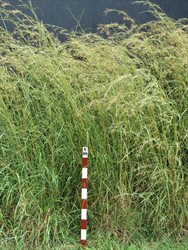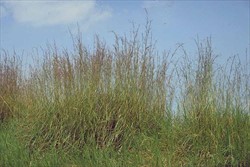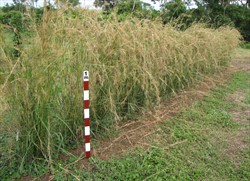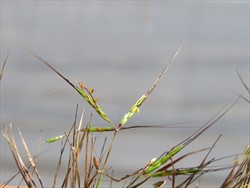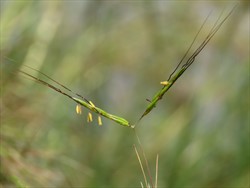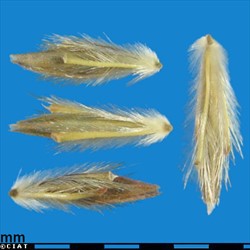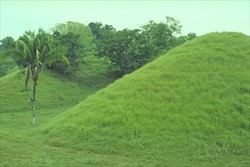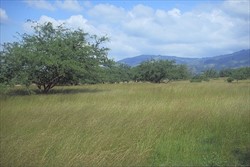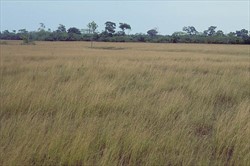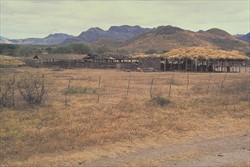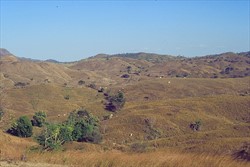Tropical Forages
Basionym: Trachypogon rufus Nees; Andropogon rufus (Nees) Kunth; Cymbopogon rufus (Nees) Rendle
Family: Poaceae (alt. Gramineae) subfamily: Panicoideae tribe: Andropogoneae subtribe: Andropogoninae.
Perennial (sometimes annual) tuft grass with short rhizomes; culm erect, 30‒250 cm long, 2‒6 mm diameter, nodes glabrous; leaf blades 30‒60 cm × 2‒8 mm, linear, apex attenuate; inflorescence a rather lax false panicle (synflorescence), much branched, 5‒80 cm long (often 1/3–1/2 of the total plant height), composed of terminal and axillary racemes; racemes not deflexed, usually rufous-hairy, 7‒14-awned per raceme pair; caryopsis ellipsoid to ovoid, ca. 3 mm long.
Similar species
H. rufa: panicle up to 80 cm long; spikelets covered with red-brown hairs
H. hirta (L.) Stapf: panicle up to 30 cm long; spikelets glabrous or covered with white hairs (Coolatai/Tambookie grass).
Africa: geelaartamboekiegras (Afrikaans); musoke, soko (Angola); nal al'afin (Arabic); khalan-soghgo, khalan-sogo-na, nyantang furo, tikole (Gambia); zankalago (Ghana); fougouli (Guinea); boka andatsika (Madagascar); nyumba ya nantchengwa, nuymbu, chipepati, cipeta, mpsyipe, kanyumbu, gogolo (Malawi); alolo, dùúl, eji, fono, gamare, ĩ̀ĩdụngurùmì, ijinga i pupu, jinfi, kalawal, kinditilo, kyara na fadama, lemmo, nal al'afin, nyanyanga, sobarla, wodeho, yamàà (Nigeria); bin blé (Senegal); tikolo yo (Sierra Leone); uoh, who (Upper Volta); alolo (Yoruba)
Asia: หญ้าแสงคำ yaa saeng kham, ya saneg kham (Thailand)
English: giant thatching grass, jaragua, jaragua grass, yellow-spike thatching grass
Europe: braunes Deckgras, Jaraguagras (German)
Latin America: capim-jaraguá, capim provisorio, jaraguá (Brazil); bermejo, faragua, puntero, yaraguá, yaraguá del Brasil (Spanish)
Native:
Africa: Eritrea, Ethiopia, Sudan, Kenya, Tanzania (incl. Pemba, Zanzibar), Uganda, Cameroon, DRC, Benin, Burkina Faso, Côte d'Ivoire, Gambia, Ghana, Guinea, Guinea-Bissau, Mali, Mauritania, Nigeria, Senegal, Sierra Leone, Togo, Botswana, Namibia, South Africa (Transvaal), Swaziland
Indian Ocean: Madagascar
Cultivated/naturalized:
Indian Ocean: Mauritius
Asia-Pacific: Australia, China, Fiji, French Polynesia, Guam, Hawaii, India, Myanmar, Thailand
Americas: USA, South America (tropical), Caribbean (West Indies, Cuba)
Forage
As native pasture, also for hay or silage, in East Africa and Latin America for beef cattle production.
Environment
It can have an adverse effect on the environment, by replacing less aggressive native grasses, particularly through its tolerance of fires, and dominating the understorey of open woodland areas. This increase in the fuel load increases the frequency and intensity of future fires, thus leading to eventual replacement of native savannas and woodlands with an exotic grassland.
Other
A useful thatching grass and general purpose straw.
Soil requirements
Prefers medium to heavy-textured soils (black clays, latosols) of medium to low fertility. Can withstand waterlogging and temporary flooding. Sensitive to high aluminium soils.
Moisture
Best with 600‒1,400 mm rainfall/yr; drought tolerant.
Temperature
Grows from 0 up to 2,000 m asl; optimum temperature range 20‒27 °C. Does not withstand frosts.
Light
Grows best in full sunlight.
Reproductive development
Jaragua grass is a short to neutral day plant.
Defoliation
Due to slow establishment, jaragua grass should not be grazed during the first 6 months. Once established, should be rotationally and heavily grazed, and/or cut short (<15 cm) in order to prevent flowering and/or tussock development with bare ground.
Fire
Being a savannah species, tolerates fire.
Guidelines for establishment and management of sown forages.
Establishment
Seed can be broadcast into ashes after burning of native vegetation; however, fully or roughly prepared seed bed gives better results; 15‒20 kg 'seed'/ha. Establishment is rather slow.
Fertilizer
Responds positively to moderate applications of N and P fertilizer, but less demanding than species such as Chloris gayana and Megathyrsus maximus.
Compatibility (with other species)
Jaragua grass competes strongly with other vegetation such as weeds and can smother them.
Companion species
Grasses: Dichanthium caricosum has similar adaptation
Legumes: Centrosema molle, Stylosanthes guianensis var. guianensis.
Pests and diseases
While a number of fungal organisms such as Curvularia sp., Fusarium sp., Phoma sorghina and Sphaeropsis sp. have been isolated from foliar lesions on H. rufa, no major diseases or pests are known.
Ability to spread
Jaragua grass spreads easily via its spikelet awns that stick to the skin of livestock.
Weed potential
Being very competitive, tolerant of drought, grazing and fire, it can be a threat to the biological diversity. In Australia, jaragua grass is considered to be an invader.
Nutritive value
Jaragua grass has a low nutritive value because of low protein and high fibre (NDF and ADF) concentrations. CP values reported depend on growth stage and season and are in the range of 1.5‒9.2%, crude fibre 29‒43%.
Palatability/acceptability
Acceptable palatability when young. Valuable as a fodder grass early in the rainy season but soon becomes stemmy and unpalatable.
Toxicity
Jaragua grass was reported to contain 0.85% oxalic acid, a level unlikely to cause oxalate poisoning in horses or cattle.
Feedipedia link
Dry matter
Dry matter yields recorded are in the range of 3.5‒10.3 t/ha/yr (up to 19 t/ha).
Animal production
The low nutritive value of Jaragua grass is reflected by rather low daily LWGs of cattle (280‒450 g/head, depending on fertilization). For acceptable LWG the grass is considered to require supplementation with nitrogen (legume tree leaves, legume grasses or a nitrogen-rich by-product) and energy sources (molasses, citrus pulp, cereal bran). With adequate supplementation and optimum pasture management high performance can be obtained.
2n = 20, 30, 36, 40. H. rufa is a facultative apomictic grass. Seeds can be produced through both selfing and outcrossing; pollination is probably wind-aided.
Reported to produce abundant seed with rapidly declining germination.
No information available.
- Drought tolerant.
- Fire tolerant.
- Thrives on heavy soils.
- Low nutritive value.
- High weed potential.
- Requires optimum management to be useful.
Skerman, P.J. and Riveros, F. (1990) Tropical grasses. Food and Agriculture Organization of the United Nations (FAO), Rome, Italy. p. 460‒464. books.google.com/books?id=tCydcW6MK60C
None released.
None reported.
